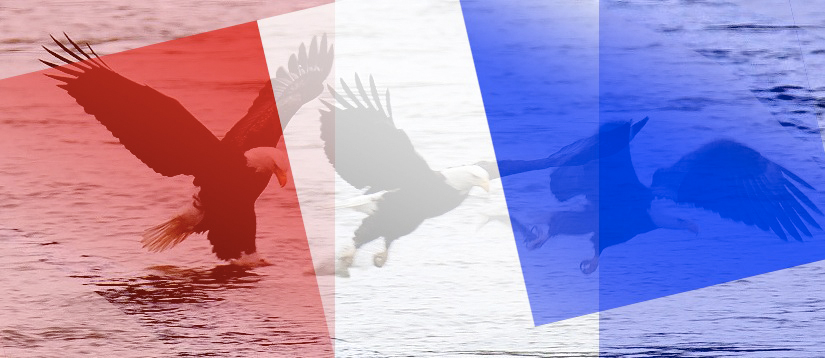Just outside of Baltimore, MD, at
the northernmost terminus of the Chesapeake Bay, there's a
hydroelectric dam, called Conowingo. When the hydroelectric
generators are running (as they very often are), fish that wander too
close to the generators' intake get sucked into the turbine and are
spit out the other side, either chopped into bits or at the very least
stunned. In winter, Bald Eagles gather by the hundreds to feed on
the disoriented fish that appear below the dam when the generators are
in operation. And on the weekends and holidays, photographers
gather by the dozens to photograph the eagles.
Getting to Conowingo is easy. From points north or south along the
eastern U.S., it's a simple matter of hopping on route 95 and taking
the Aberdeen exit. There are several very affordable hotels in
Aberdeen, for those making a several-day visit from afar. From
Aberdeen, the dam can be reached in about 15 minutes by taking route
462 ("Paradise Road") north to route 155, hanging a left onto 155 and
then a right onto 161, a right onto Shuresville Road, and finally
another right onto Shure's Landing Road, which dead-ends at the dam.

This past winter I decided to spend my christmas vacation at Conowingo,
to see if I could finally get some decent Bald Eagle photos.
Though the week I chose turned out to be one of the worst weeks of the
season (all the locals agreed that the numbers of eagles present during
that week were substantially below the norm), I was able to get a
number of very satisfactory images, as you'll see below.
First, a few more bits of information about
visiting Conowingo. The best time of year for eagle activity at
the dam is apparently right around Thanksgiving. That's when the
peak numbers of eagles are generally seen. Their numbers build up
during late autumn, stay relatively stable for a while during winter,
and then drop off as the birds start to feel their reproductive
instincts kick in during late winter. They can be active any time
during the day (even on rainy days), but their feeding opportunities
are largely dictated by the status of the hydroelectric generators
(more on this later in the article).
The facilities at the dam are quite
adequate. There is more than ample parking, there are heated
restrooms with vending machines, and there's lots of space for hordes
of photographers to set up along the banks of the river below the
dam. The visitor area is open from before dawn till after dusk,
though there's a gate at the entrance that apparently locks at
night. There are gas stations and convenience stores just a few
minutes away on route 1 (the road that runs across the dam), so
batteries and hot coffee are readily available when needed.
Now, let's see what kind of photos one can get
at the dam with a long telephoto lens. Below is my "trophy case"
from this first visit to the dam, which I hope to add to on future
visits. Further down on this page, after the trophy case, you'll
find more info on shooting at this location, including recommendations
for lenses, camera settings, effective use of flash at this location,
and more.
The Trophy Case
Below are the
photos that I was most satisfied with from my first, week-long visit to
Conowingo. Keep in mind that this was an unusually slow week at
the dam, with far fewer eagles present than normal. Click on any
thumbnail to view the full image.
You can also view these photos as a
slideshow.
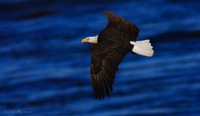 |
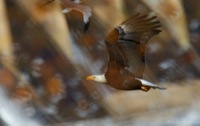 |
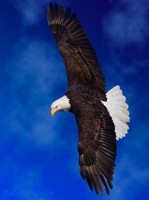
|
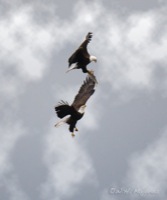 |
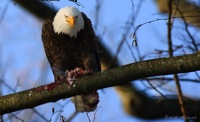
|
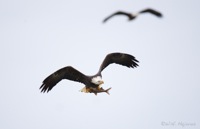 |
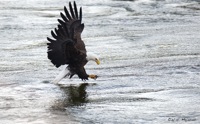 |
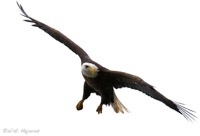 |
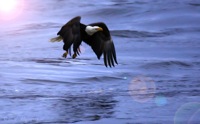 |
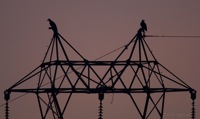 |
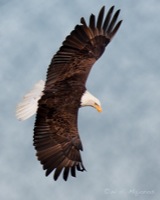
|
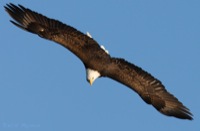 |
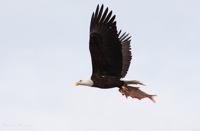 |
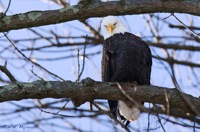 |
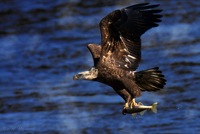 |
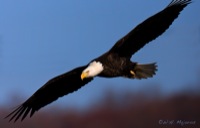 |
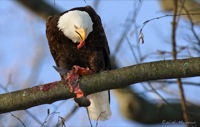 |
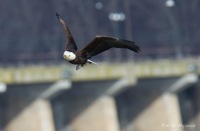
|
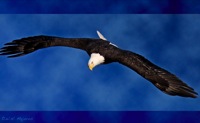 |
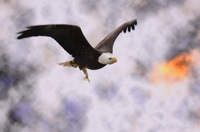 |
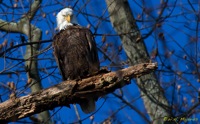
|
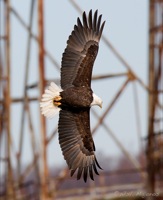 |
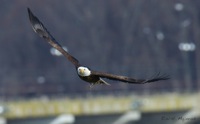 |
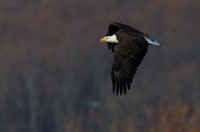 |
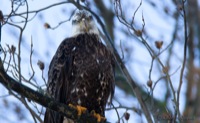 |
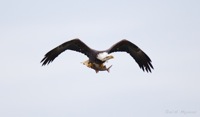 |
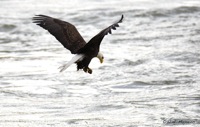 |
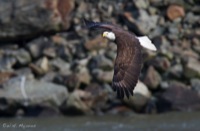 |
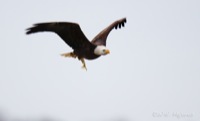 |
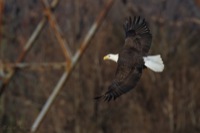 |
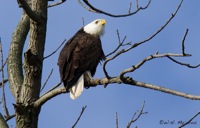 |
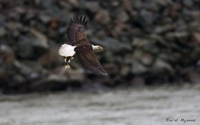 |
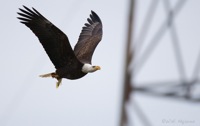 |
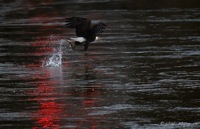 |
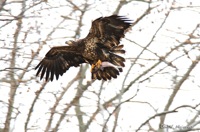 |
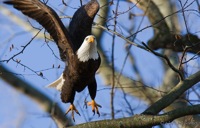 |
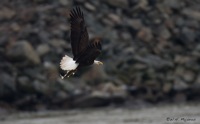 |
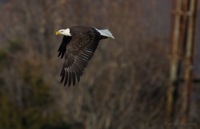 |
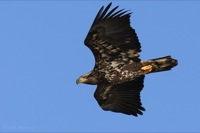 |
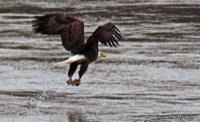 |
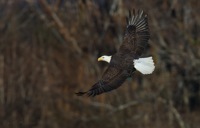 |
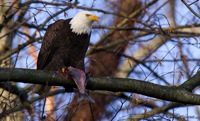 |
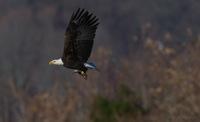 |
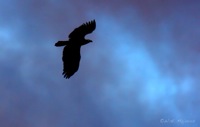 |
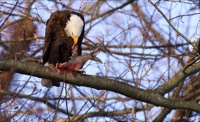 |
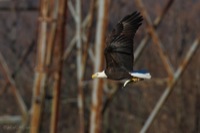
|
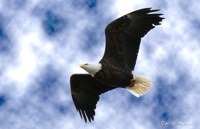 |
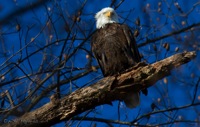 |
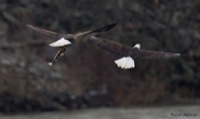 |
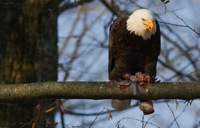 |
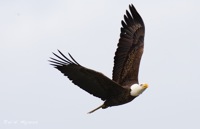 |
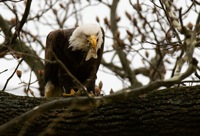 |
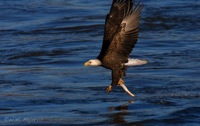
|
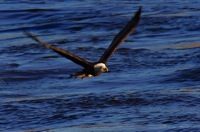
|
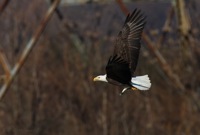
|
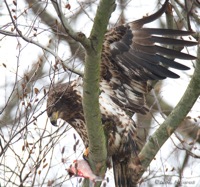
|
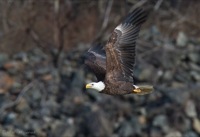 |
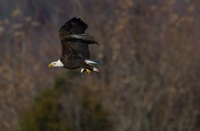 |
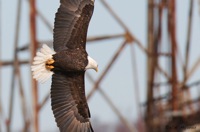 |
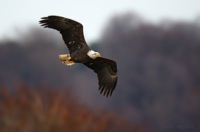 |
Other
Species at the Dam
There
are a number of other bird species at the dam that are worth
photographing. The number of gulls (mostly Ring-billed) present
during my visit was just staggering. I found the background
colors at the site and the ability to get down close to the water at
the boat ramp very amenable to gull shooting:
|
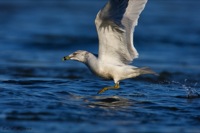 |
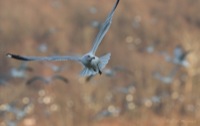 |
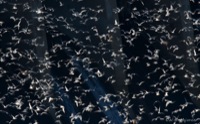 |
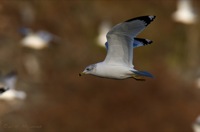 |
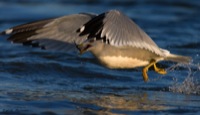 |
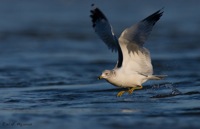 |
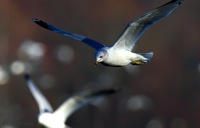 |
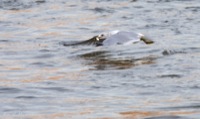 |
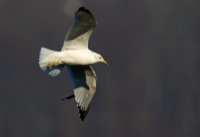 |
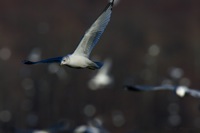 |
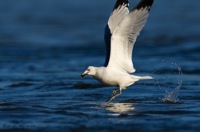 |
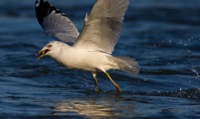 |
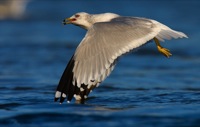 |
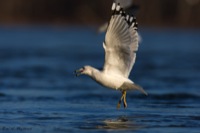 |
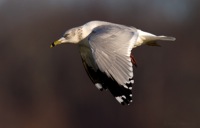 |
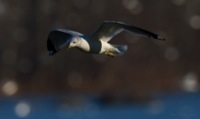 |
Several other raptors were seen during my visit, including the
Red-tailed hawk and the Peregrine Falcon shown below, as well as a
Sharp-shinned hawk that I wasn't able to catch:
|
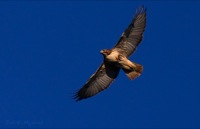 |
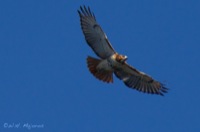 |
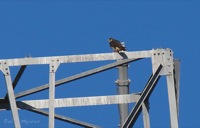 |
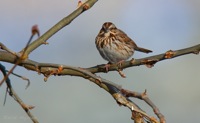 |
The sparrow shown above is a Song Sparrow; though I didn't investigate
further, there were many sparrows on the road leading into the
visitors' area. Also seen during my trip were a Winter Wren, a
Golden-crowned Kinglet, both common vulture species, crows, and scores
of Great Blue Herons (who have a rookery across the river). The
Peregrine shown above was perched atop one of the enormous utility
towers on an island in the river (see below), at a distance of probably
700 feet; the image shown is full-frame (no cropping), so details
aren't terribly sharp. According to the locals, this bird likes
to perch on the towers, and will sometimes evict eagles from
them.
Note that although Golden Eagles are known to
show up at the dam occasionally, many juvenile Bald Eagles seen from a
distance can look frustratingly like a Golden to the untrained
eye. If you're not an experienced eagle watcher, ask someone more
in the know before checking that box next to "Golden Eagle" on your
life-list when you see a large brown eagle fly by.
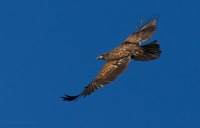
Photography
Tips for Conowingo
During
my stay at Conowingo, I interacted extensively with the regular
photographers there and learned much about the art of eagle photography
at Conowingo. Hopefully, some of what follows will be useful to
you if you decide to visit Conowingo in the future.
My first piece of advice is to make friends
with the other photographers, since they (as a group) have many more
eyeballs than you do, and those eyeballs are very useful. When an
eagle decides to make a close fly-by, its approach can be very
quick. Getting a "heads up" from other photographers or birders
in the vicinity can make the difference between getting the shot and
not getting the shot. All of the photographers that I met at
Conowingo were exceedingly friendly and willing to share any
information they had about birds. I owe more than a few of the
shots above to their gracious help.
Lenses
Of the
truly serious eagle photographers there at Conowingo that week, the
vast majority were shooting with Canon's 500mm f/4.0 lens. I'm
talking about the really serious photographers who were getting
stunning images of the birds. There were also a number of other
"casual" bird photographers there with 400mm lenses and even a few with
smaller, all-in-one systems, but 500mm was by far the most popular
focal length among the most dedicated, hard-core eagle
photographers. Several of these people were using that lens
hand-held, with a half-monopod attached to facilitate a better grip;
they'd anchor the half-monopod against their hip to provide better
stability. A few shooters (myself included) were instead using the Canon
600mm f/4 lens, and one fellow even took his 600 off the tripod
briefly for a couple hand-held shots. The new Canon 800mm lens (which
goes for $11,000) made a few appearances, and one woman had the old
Canon FD 800mm manual-focus lens, which she got off of eBay for $300
(she wasn't getting any flight shots, though, since her lens lacked
autofocus). The 800mm Sigmonster
lens (which runs about $6500) also made an appearance. Those
photographers using 500mm and 600mm lenses alternated between using a 1.4x
teleconverter and using no converter. The ability to take off
the converter in low-light conditions (which occurred quite often) no
doubt gave some advantage over those with the fixed 800mm lens,
especially for birds in flight.
Despite the popularity of the 500mm-and-up
category among the hardcore crowd, I think 400mm lenses can be
extremely useful at Conowingo:
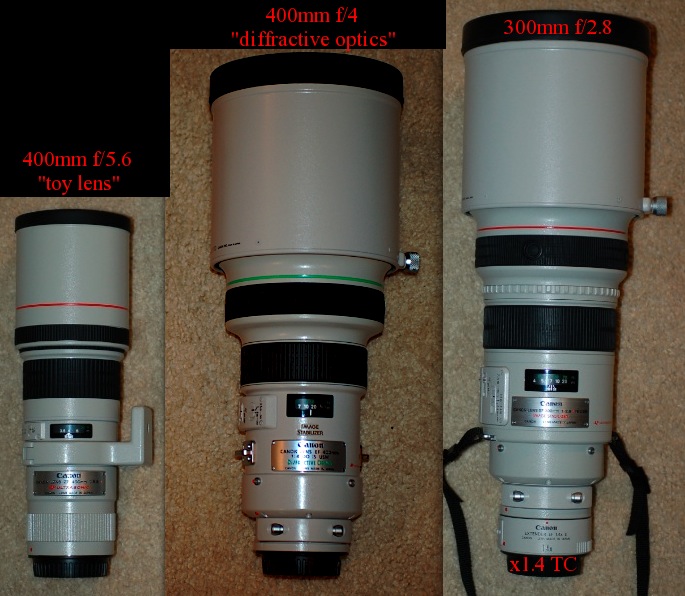
In addition to my 600mm/840mm
tripod-mounted rig, I also kept a 400mm
f/4 lens, with camera attached, slung over one shoulder. For
eagles out over the water hunting fish, the big lenses are pretty much
necessary if you want all the feather detail in the bird.
However, many of the eagles, after catching a fish, will fly up to a
perch along or behind the parking lot where the photographers are, and
as the bird approaches you can get stunning in-flight shots with a
400mm lens. In fact, with any more than 400mm you typically can't
fit the whole bird in frame when it's passing right over you. So
if you don't have a big 500/600/800mm lens, don't think that a trip to
Conowingo is pointless. Those few Nikon shooters I
encountered overwhelmingly preferred the Nikon 200-400mm VR zoom lens,
with or without teleconverter.
Eagle
Behavior
There
are definitely some consistent patterns in the behavior of the eagles
at
Conowingo, which you can use to your advantage in trying to be prepared
for the next shot. First, there are the preferred perches of the
birds. Many birds perch all the way across the river, or on the
rocks below the dam. These birds are simply too far away, so
forget about them. The other two popular perching areas are the
electrical
towers on the island, and in the trees lining the parking lot.

The birds on the towers have a clear view of both channels of the river
--- i.e. both the channel right in front of you, and the channel on the
far side of the island. When you're lucky, they'll decide to do
their hunting in the near channel. Keeping an eye on the eagles
perched in the towers will help you be prepared for their fishing
runs. Unfortunately, the fishing activity can take place along a
pretty long stretch of river, so that the actual fish captures may or
may not take place right in front of you. The best way to
position yourself along the river bank is to figure out which of the
local photographers is the most knowledgeable, and follow him/them
around. Some of these people have been coming to the dam for 15
years, and they can often predict with uncanny accuracy where the
hunting
is likely to take place, based on the water level, how long the
generators have been running, the locations of perched birds,
etc.
Once a bird has caught a fish, follow it by
eye to see both where it is headed and whether it is being followed by
any other eagles. Immediately after a fish capture there can be
fights among the eagles as one bird attempts to steal the catch from
the other. These pursuit flights can involve more than two birds,
and can be very exciting, though due to their fast pace they can also
be frustratingly brief. Often a bird being pursued or harassed by
another eagle will drop its fish into the river, and then the pursuer
will attempt to retrieve it from the water, providing you with another
chance to get some fishing shots, from that very same fish. Fish
are sometimes even dropped right in the parking lot.
Eagles will often perch in the trees lining the parking lot, and this
sometimes provides a great opportunity for stationary shots of the
birds:
After
catching a fish, many eagles will take their catch to a tree
right next to the parking lot, and you can photograph them eating the
fish from very close distances.
Eagles will also hunt from those
same perches, by watching the surface of the water for signs of
fish.
If you find an eagle perched along the parking lot that
isn't preening, but is attentively watching the water, that bird may be
likely to launch into flight sometime soon, so it may be prudent to
keep your camera trained on that bird. If you time it just right,
you can get a "jump shot" of the bird just as s/he is launching into
flight from the perch:
Note that some individual birds exhibit consistent behavioral patterns,
which you can use to your advantage. For example, this bird,
which we knew as "Zorro", had a preferred perch that s/he like to go
to, and we also knew that s/he had a high success rate at catching
fish, so that if several eagles were in the air, s/he was the one to
watch:
Here's another bird that we knew as "Mohawk", who tended to catch fish
close to the dam and then take them to the trees near the restroom:
As just one more example of behavioral patterns, several of us noticed
that
many of the birds had a tendency of looking down once at the fish which
had just been caught, providing one last chance to catch a facial shot
of the bird before it returned to the island:
Use of Flash
The use
of flash at Conowingo is a tricky business. Even with the popular
Better Beamer (a small fresnel lens which attaches to your external
flash unit), the range of your flash will not be enough to illuminate
birds far out over the water. Birds perched along the parking lot
are ideal for flash, as long as you have a beamer. During the
day, the birds don't seem to mind the flash at all, though if you flash
them at dusk they will often fly off.
For birds out over the water, even the Better
Beamer can be inadequate. Several of the local photographers at
Conowingo have surmounted this difficulty (to some degree) by building
their own, much larger beamers, which can magnify the light from your
flash substantially more than a standard beamer:
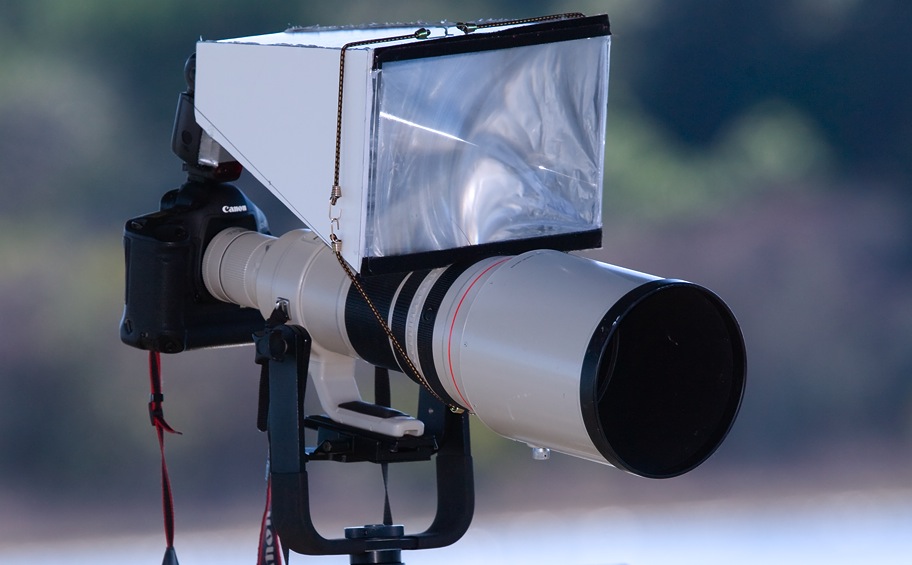
These home-made beamers are easy to construct, using materials readily
available from art supply stores. Following the advice of a
photographer at Conowingo, I built mine using a fresnel lens from
Barnes-and-Noble and some foam-core, hot glue, and styrofoam from
Michael's. Mini bungee cords from Wal-Mart completed the
package. Even with such a mega-beamer, fully illuminating an
eagle
far out on the river simply isn't possible, though I did note that I
was able to induce eye-shine in eagles perched on the electrical towers
out
on the island --- fully 700 feet away:
Camera
Settings
Most of
the bird photography I've done has been of stationary birds --- usually
small birds like warblers and the like. For large, fast-moving
birds like eagles, there are several things that I found I needed to
change about how I set up the camera (largely due to the help of an
expert Conowingo photographer named Andy). First, for the flash I
switched to using high-speed sync.
I typically avoid high-speed
sync, because at higher shutter speeds very little of the light from
the flash reaches the subject, due to the "windowing" effect of the
shutters. For eagles in flight, however, the
max sync speed on my camera (1/300 sec for the Canon
EOS 1D Mark III) simply isn't fast enough to freeze the motion of
the bird. Shutter speeds in the vicinity of 1/640 to 1/1250 are
more likely to freeze an eagle in flight. At Conowingo I found it
useful to re-program the "quick dial" on my camera so that I could
quickly dial down the shutter speed to no more than 1/640 or 1/800, so
that some of the light from my flash could reach the bird. In the
end, I think few of the successful photos of birds in flight were
impacted by the flash anyway.
A far more important consideration was the
basic metering of the bird. Following Arthur Morris and others,
I've adopted aperture-priority mode
("Av" on Canon bodies) as my
default metering mode, and this has worked very well so far. My
quick dial is programmed for exposure
compensation, so after a quick
first shot to judge exposure, I can rapidly dial in an exposure
compensation for subsequent shots. I quickly learned that most of
the serious eagle photographers at Conowingo shoot exclusively in manual exposure
model ("M" on Canon bodies), and I was soon to follow suit.
Though manual mode
may sound a bit scary, it's actually just as easy to manage as Av once
you've got a baseline setting, since you can rapidly dial in
adjustments using the quick dial.
For baseline exposures, the photographers at
Conowingo rely on a handful of white landmarks nearby. On sunny
days, they find the whitest rock visible on the island and shoot a test
shot of that, then adjust their shutter speed and aperture until the
"highlight alerts" on their camera just start to blink (shown as red in
the photos below):
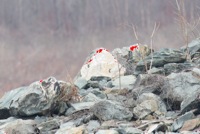
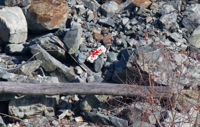
On overcast days they use a white sign out on the island (again, red
indicates the highlights that would be flashing on the camera's LCD):
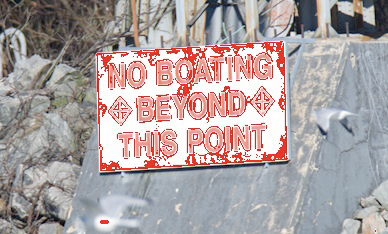
At dusk
they use the white bark on a sycamore tree next to the parking
lot. By calibrating their exposure to these white landmarks, they
can be sure that they won't blow the highlights on an eagle's white
head. Everything else is relative to that. The background
may end up being overexposed, or the brown of the eagle's body might be
underexposed, but without feather detail in the bird's white head (the
most prominent part of any Bald Eagle), the resulting photo would be
sub-par anyway. Everything else can be fixed in postprocess (ie.,
in Photoshop).
For action shots, it's best to keep your camera in high-speed drive mode
(10 frames-per-second on my camera) and to "spray and pray". Keep in
mind that if you're
using flash, only the first frame may be illuminated, unless you have a
fast-recycle flash unit and/or battery pack. For flight shots,
you'll want predictive focusing
mode ("AI Servo" on Canon bodies), and
you may want to check whether the number of focus points on your camera
can be tweaked. On my body, it turned out to be useful to set the
custom function which allows the focus to switch to adjacent focus
sensors when the subject drifts off of the central sensor, and to use
"focus priority" tracking rather than "drive
priority" tracking. Without these settings, my camera tended to
want to focus on the background rather than the bird:
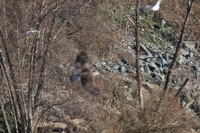
If you like smooth backgrounds that emphasize the subject, then keep
your apertures fairly wide. Remember that for any aperture,
depth-of-field increases with distance to the subject. When the
bird is gliding low over the water, a narrow depth-of-field becomes
necessary to avoid giving too much detail to the background:
When the bird is higher, depth-of-field becomes less important, because
any background features that you don't like can be more easily edited
out in Photoshop:
Other
Considerations
There
are a number of other tips that the generous photographers at
Conowingo shared with me during my stay; I'll mention just a few.
The first is to continually re-check your exposure, since the light
levels can change rapidly as clouds come and go. Also keep alert
for birds in flight --- eagles can approach from any angle, even from
behind the parking lot, since they roost back there. The sooner
you detect one approaching, the greater your chance of being prepared
when the bird arrives within photographing distance. Also stay
aware of the state of the hydroelectric generators. When the
generators start up, red lights will flash and a loud siren will whine,
giving a several-minute warning before the floodgates open.
The eagles have become conditioned to associate these signals with the
arrival of food, and they can burst into a feeding frenzy just after
the sirens go off:
You'll maximize your chances of getting some
good
shots if you put in a full day. Arrive before light and stay
until
dark (remember that silhouettes can sometimes make good images).
Go out even in rain or snow --- precipitation and overcast lighting can
provide an interesting mood to shots. Move around a lot and take
note of how light and color change as your angle to the water
changes. You can sometimes change the color of the water just by
changing your angle slightly (though changes in cloud cover can have a
big effect too):
Most importantly, stay
close to the most experienced photographers in the crowd --- watch what
they do, heed their advice, and don't get distracted by people who
talk too much.
|
|
